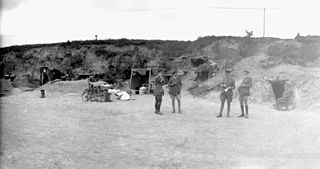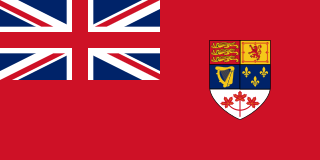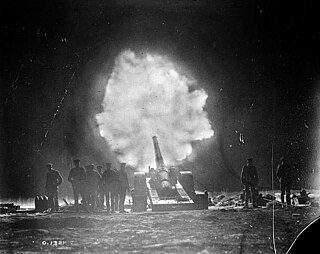
The Battle of Vimy Ridge was part of the Battle of Arras, in the Pas-de-Calais department of France, during the First World War. The main combatants were the four divisions of the Canadian Corps in the First Army, against three divisions of the German 6th Army. The battle took place from 9 to 12 April 1917 at the beginning of the Battle of Arras, the first attack of the Nivelle Offensive, which was intended to attract German reserves from the French, before the French attempt at a decisive offensive on the Aisne and the Chemin des Dames ridge further south, several days later.

In German heroic legend, Alberich is a dwarf. He features most prominently in the poems Nibelungenlied and Ortnit. He also features in the Old Norse collection of German legends called the Thidreksaga under the name Alfrikr. His name means "ruler of supernatural beings (elves)", and is equivalent to Old French Alberon or Auberon.

General Sir Arthur William Currie, was a senior officer of the Canadian Army who fought during World War I. He had the unique distinction of starting his military career on the very bottom rung as a pre-war militia gunner before rising through the ranks to become the first Canadian commander of the Canadian Corps. Currie's success was based on his ability to rapidly adapt brigade tactics to the exigencies of trench warfare, using set piece operations and bite-and-hold tactics. He is generally considered to be among the most capable commanders of the Western Front, and one of the finest commanders in Canadian military history.

The Canadian Corps was a World War I corps formed from the Canadian Expeditionary Force in September 1915 after the arrival of the 2nd Canadian Division in France. The corps was expanded by the addition of the 3rd Canadian Division in December 1915 and the 4th Canadian Division in August 1916. The organization of a 5th Canadian Division began in February 1917 but it was still not fully formed when it was broken up in February 1918 and its men used to reinforce the other four divisions.

The 1st Canadian Division is a joint operational command and control formation based at CFB Kingston, and falls under Canadian Joint Operations Command. It is a high-readiness unit, able to move on very short notice, and is staffed and equipped to meet Canada’s military objectives to counter any potential threat.

The Canadian National Vimy Memorial is a war memorial site in France dedicated to the memory of Canadian Expeditionary Force members killed during the First World War. It also serves as the place of commemoration for Canadian soldiers of the First World War killed or presumed dead in France who have no known grave. The monument is the centrepiece of a 100-hectare (250-acre) preserved battlefield park that encompasses a portion of the ground over which the Canadian Corps made their assault during the initial Battle of Vimy Ridge offensive of the Battle of Arras.

Hawthorn Ridge Redoubt was a German field fortification, west of the village of Beaumont Hamel on the Somme. The redoubt was built after the end of the Battle of Albert and as French and later British attacks on the Western Front became more formidable, the Germans added fortifications and trench positions near the original lines around Hawthorn Ridge. At 7:20 a.m. on 1 July 1916, the British fired a huge mine beneath the Hawthorn Ridge Redoubt. Sprung ten minutes before zero hour, the mine was one of 19 mines detonated on the first day of the Battle of the Somme. Geoffrey Malins, one of two official war cameramen, filmed the detonation of the mine. The attack on the redoubt by part of the 29th Division of VIII Corps was a costly failure.

The Canadian Red Ensign served as a nautical flag and civil ensign for Canada from 1892 to 1965, and later as the de facto flag of Canada before 1965. The flag is a British Red Ensign, with the Royal Union Flag in the canton, adorned with the shield of the coat of arms of Canada.

The Third Battle of Artois was fought by the French Tenth Army against the German 6th Army on the Western Front of the First World War. The battle included the Battle of Loos by the British First Army. The offensive, meant to complement the Second Battle of Champagne, was the last attempt that year by Joseph Joffre, the French commander-in-chief, to exploit an Allied numerical advantage over Germany. Simultaneous attacks were planned in Champagne-Ardenne to capture the railway at Attigny and in Artois to take the railway line through Douai, to force a German withdrawal from the Noyon salient.

The military history of Canada during World War I began on August 4, 1914, when the United Kingdom entered the First World War (1914–1918) by declaring war on Germany. The British declaration of war automatically brought Canada into the war, because of Canada's legal status as a British Dominion which left foreign policy decisions in the hands of the British parliament. However, the Canadian government had the freedom to determine the country's level of involvement in the war. On August 4, 1914, the Governor General declared a war between Canada and Germany. The Militia was not mobilized and instead an independent Canadian Expeditionary Force was raised.

Andrew Barrett Godefroy CD is a Canadian strategic analyst and science and technology historian.

The Second Battle of Passchendaele was the culminating attack during the Third Battle of Ypres of the First World War. The battle took place in the Ypres Salient area of the Western Front, in and around the Belgian village of Passchendaele, between 26 October and 10 November 1917. The Canadian Corps relieved the exhausted II Anzac Corps, continuing the advance started with the First Battle of Passchendaele and ultimately capturing the village. Beyond gaining favourable observation positions, the battle was intended to gain drier winter positions on higher ground.

The Battle of Mont Sorrel was a local operation in World War I by three divisions of the German 4th Army and three divisions of the British Second Army in the Ypres Salient, near Ypres in Belgium, from 2 to 13 June 1916.

The Battle of Vimy Ridge was a military engagement fought as part of the Battle of Arras, in the Nord-Pas-de-Calais region of France, during the First World War. The main combatants were the Canadian Corps against three divisions of the German Sixth Army. The battle was part of the opening phase of the Battle of Arras, part Nivelle Offensive and took place from 9–12 April 1917. The objective of the Canadian Corps was to take control of the German-held high ground, along an escarpment at the northernmost end of the Arras Offensive. This would ensure that the southern flank could advance without suffering German enfilade fire.
The 50th Battalion (Calgary), CEF, was an infantry battalion of the Canadian Expeditionary Force during the Great War. The 50th Battalion was authorized on 7 November 1914 and embarked for Britain on 27 October 1915. The battalion disembarked in France on 11 August 1916, where it fought as part of the 10th Canadian Infantry Brigade, 4th Canadian Division, in France and Flanders until the end of the war. The battalion was disbanded on 30 August 1920.
The Canadian Battlefields Memorials Commission was a special commission established by the House of Commons of Canada, on the recommendations of the British Battle Exploits Memorials Committee. The Canadian House of Commons established the committee in September 1920 with the mandate of selecting and establishing First World War memorial sites in France and Belgium.
This is a bibliography of works on the military history of Canada.
Victor, baron d'Urbal was a French officer during the First World War.

The following events occurred in April 1917:
Brigadier-General Norman William Webber was a staff officer in the British Army in World War I, who served as Chief of Staff to Lieutenant-General Sir Arthur Currie, Commander of the Canadian Corps, prior to and during the period known as ‘Canada's Hundred Days.’ He received 9 'Mentions in Despatches' during the war.














